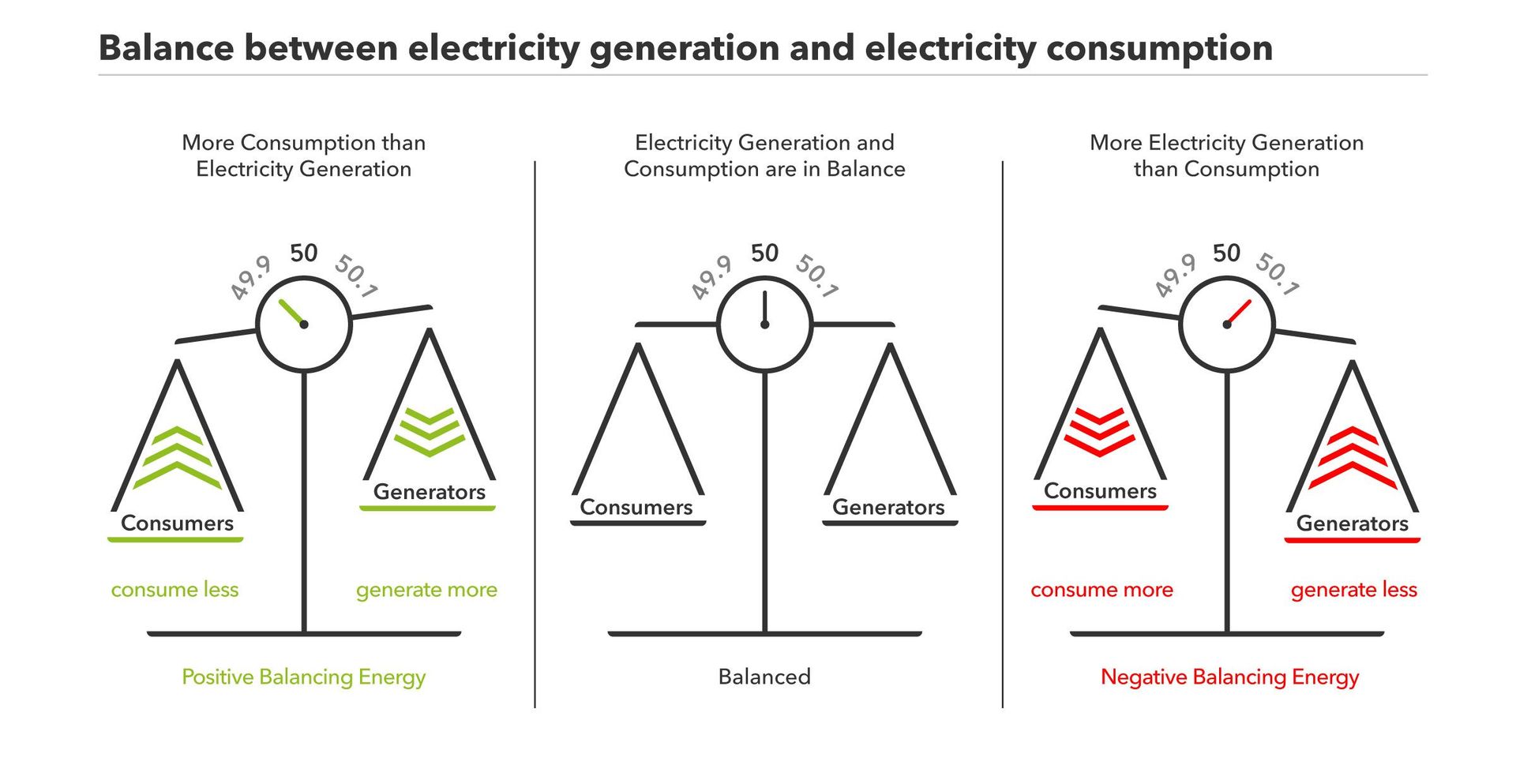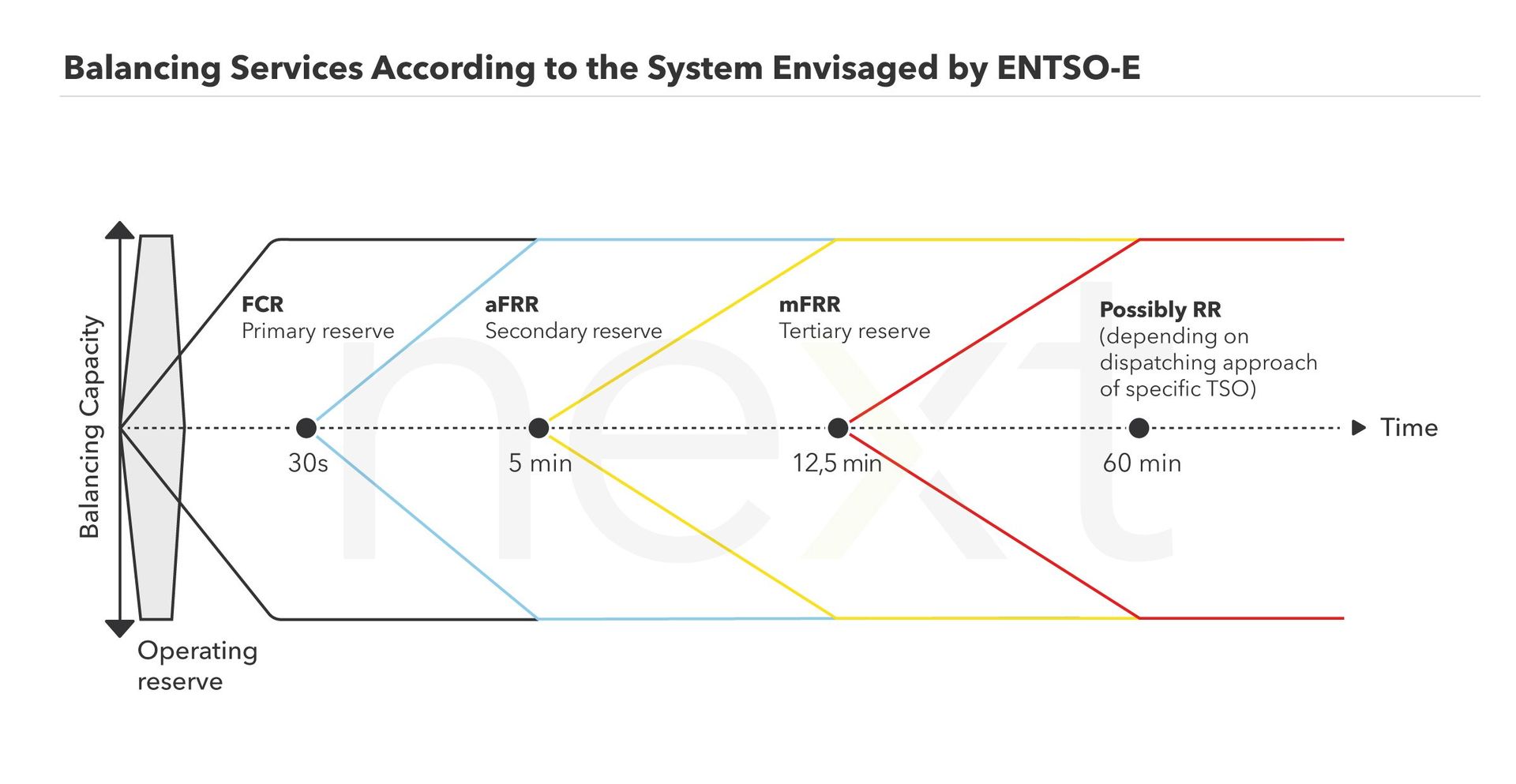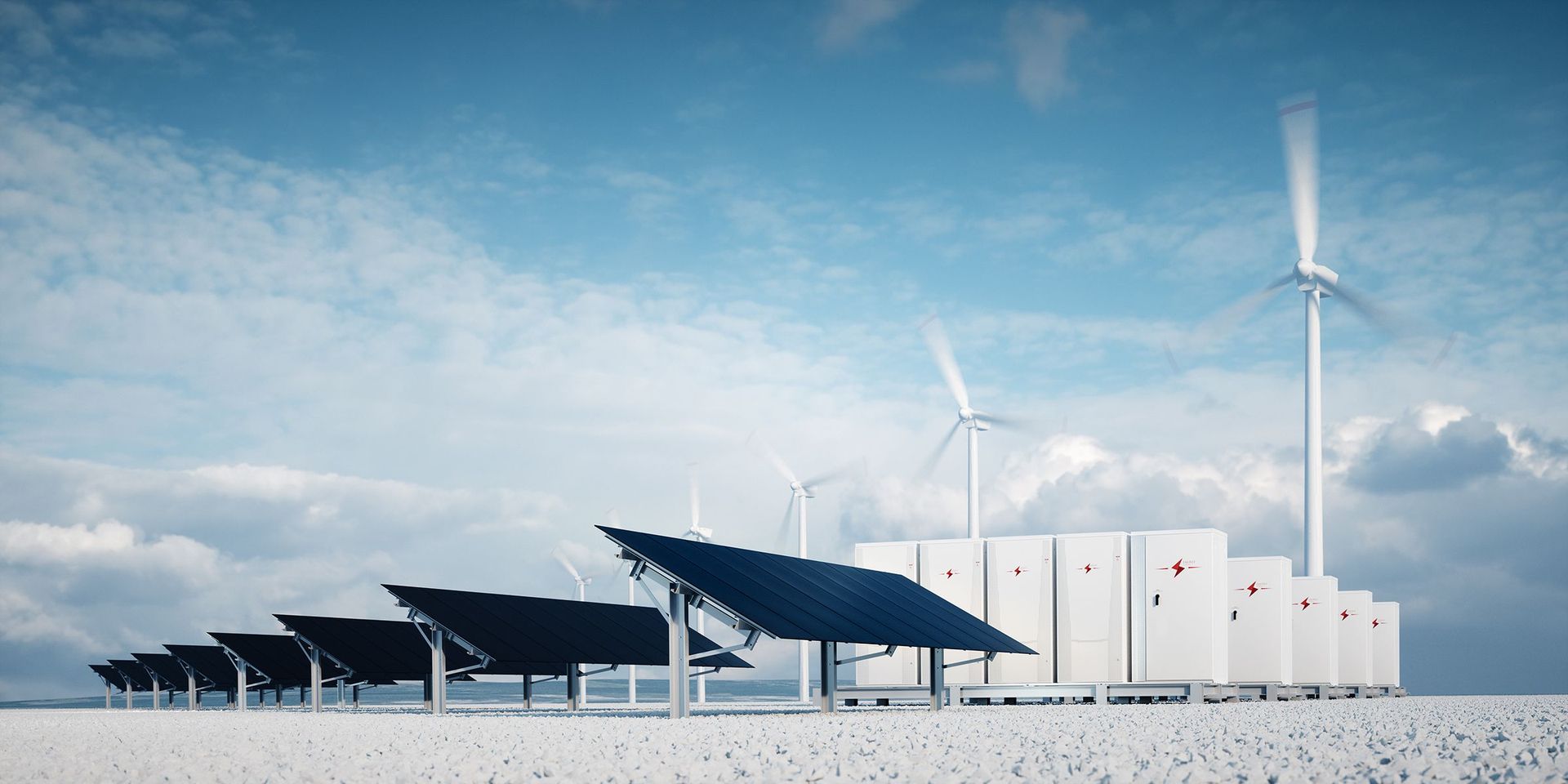What is aFRR (automatic frequency restoration reserve) and how does it work?
Definition
The automatic Frequency Restoration Reserve (aFRR), also known as secondary reserve, is a reserve in the power grid that helps to keep the grid frequency stable. To keep the frequency within certain thresholds, the Transmission System Operators (TSOs) activate balancing services like aFRR, which they acquire from Balancing Service Providers (BSPs). Countries differ in their specifications but after European harmonization of the balancing markets, BSPs need to ensure that they provide the reserve within 5 minutes (Full Activation Time). As the secondary reserve, aFRR replaces the FCR gradually after 30 seconds, the mFRR, the tertiary reserve, supports or partially substitutes the aFRR after 12.5 minutes.
Table of Contents
- What is aFRR and why do we need it?
- FCR, aFRR and mFRR: What is the Difference?
- aFRR in Europe: Platform for the International Coordination of Automated Frequency Restoration and Stable System Operation (PICASSO)
- PICASSO members:
- PICASSO observers:
- How do auctions and bids of balancing energy from frequency restoration reserves with automatic activation work?
- aFRR: Where are we heading?
What is aFRR and why do we need it?
In order to work properly, power grids need to maintain a frequency of 50 Hz or in some countries of 60 Hz. If they surpass a certain threshold (+/- 0.2 Hz), a brownout or even a blackout can follow. The system operators are responsible to maintain the grid frequency and use balancing services (control reserve), like aFRR to do so. To keep the grid frequency stable, input and output need to be in balance at all times.
Up to now, power plants that can be controlled well and switched fully automatically, such as pumped-storage power plants or gas turbines, are the main providers of secondary reserve. However, in some countries, for some years now, virtual power plants from biogas plants or CHP units have also been contributing secondary control power to grid stability.
Market design and rules for providing aFRR vary around the world and within Europe. However, as part of the harmonization of the European balancing markets, there are established guidelines, the European Balancing Guidelines (EB GL) that define framework conditions for the participating nations. In this article, we will use these guidelines to explain aFRR in more detail.
FCR, aFRR and mFRR: What is the Difference?
FCR, aFRR and mFRR differ in their activation time and how these products provide balancing energy. Therefore we focus on the TSOs activate aFRR automatically after 30 seconds. If the grid imbalance persists after 12.5 minutes, the mFRR supports or replaces aFRR gradually.
The TSOs use positive balancing energy when generation is low and consumption is high. Now either generation units need to feed in more and/or consumers need to reduce their outtake. Negative balancing energy is exactly the other way around.

As is the case with mFRR, most countries have two forms of remuneration for aFRR: one for keeping the capacity available in case of activation and one for actually activating the balancing energy:
- Capacity Price/ capacity remuneration: BSPs are paid for holding back flexible capacities they can activate in case of imbalances.
- Energy Price / balancing energy remuneration: BSPs get a payment for providing the reserve (e.g. feeding in more/less, consuming more/less).

aFRR in Europe: Platform for the International Coordination of Automated Frequency Restoration and Stable System Operation (PICASSO)
In the course of the harmonization of the European balancing energy markets, the Platform for the International Coordination of Automated Frequency Restoration and Stable System Operation (PICASSO) will be established. The goal is a shared platform where aFRR can be exchanged between countries. In order to do so, the different market designs of the countries need to follow some rules established by the EB GL, System Operation Guideline (SO GL) and Guideline on Capacity Allocation and Congestion Management (CACM).
There is an accession roadmap, which is updated twice a year and maps out the go live dates of the connection to the platform in each country. In the current document, the first TSO connects to the aFRR platform in Q3/2021. The planned go-live date of the platform is in Q3/2022. Some TSOs have special arrangements governing later joining
Nineteen TSOs take part in the PICASSO project with three TSOs and ENTSO-E participating as observers.
PICASSO members:
| Country | TSO |
|---|---|
| Austria | APG |
| Belgium | Elia |
| Bulgaria | ESO |
| Croatia | HOPS |
| Czech Republic | ČEPS |
| Denmark | Energinet |
| Finland | Fingrid |
| France | RTE |
| Germany | 50Hertz, Amprion, TenneT DE, TransnetBW |
| Greece | ADMIE |
| Hungary | MAVIR |
| Italy | Terna |
| Luxembourg | Creos Luxembourg S.A. |
| Netherlands | TenneT NL |
| Norway | Statnett |
| Poland | PSE S.A. |
| Portugal | REN |
| Romania | Transelectrica |
| Slovak Republic | SEPS |
| Slovenia | ELES |
| Spain | Red Eléctrica de España |
| Sweden | Svenska Kraftnät |
| Switzerland | swissgrid |
PICASSO observers:
| Country | TSO |
|---|---|
| Latvia | Augstsprieguma tÏkls (AST) |
| Lithuania | Litgrid |
| Estonia | Elering |
| North Macedonia | Macedonian Transmission System Operator (MEPSO) |
| + ENTSO-E | - |
How do auctions and bids of balancing energy from frequency restoration reserves with automatic activation work?
In most countries with a liberalized balancing energy market, the TSOs organize the auctions to procure the amount of balancing energy needed. The TSOs specify the amount of control energy based on historical data and the respective market design. In general: TSOs tender the quantities they need and BSPs can submit their bids, which the TSOs also organize.
In many countries, a merit order list determines who gets the acceptance of the bid. This means that bids are ranked by price in ascending order. In case of activation, bids are called until the demand has been met. This means that an expensive bid is less likely to be accepted than a cheaper one.
While the general concept is quite similar in most countries, the specifications of the tenders and market rules differ from country to country. However, to allow a cross-border exchange of aFRR some framework conditions need to be aligned across national borders. In particular technical specifications of the product.
As the PICASSO platform develops, the participating TSOs propose the following guidelines in their implementation framework:
Each standard aFRR product bid needs to fulfill the following requirements:
| Mode of activation | automatic |
|---|---|
| Full Activation Time (FAT) | 5 minutes |
| Minimum quantity | 1 MW |
| Minimum granularity | 1 MW |
| Validity Period | 15 minutes |
| Divisibility | Each product shall be divisible and the activation request can be lower than the minimum granularity |
| Minimum delivery time | No |
| Gate closure time for bids | 25 minutes before validity period |
The Common Merit Order List (COML) arranges the bids submitted from the TSOs combined.
In contrast to the simple model of the merit order list explained earlier, the COML adds some factors to arrange the bids, for example cross-border interconnectors.
However, it is not only the price of the bids that is important, but also whether the exchange of the aFRR can take place and whether the load on the networks is relieved as much as possible. The activation optimization function (AOF) is used for this purpose. The function helps to organize the bids in such a way that other parameters, such as cross-zonal capacities, can be factored in.
More to read
aFRR: Where are we heading?
In many countries, aFRR is a significant balancing service used when it comes to eliminating grid imbalances. Some critics repeatedly raise the point that increased integration of volatile power producers, such as wind and solar, would unbalance the grid and require more balancing power. However, we actually see a drop in quantities activated. One reason is that the forecasting of the feed-in of volatile renewable energy becomes better and better and grid imbalances become easier to predict.
New and innovative participants on the balancing markets like Virtual Power Plants are important due to conventional power plants leaving the market.
As for aFRR, it is expected that with the full implementation of PICASSO market efficiency can be increased due to more liquidity and competition.
Disclaimer: Next Kraftwerke does not take any responsibility for the completeness, accuracy and actuality of the information provided. This article is for information purposes only and does not replace individual legal advice.


